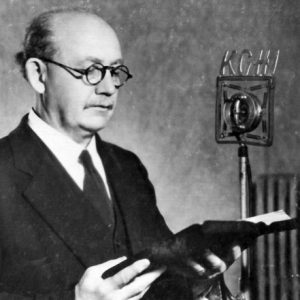calsfoundation@cals.org
Dora G. B. Marcusben
2015 April Fools' Day Entry
Dora B. G. Marcusben was the pseudonym under which Missionary Baptist leader and Ku Klux Klan member Benjamin Marcus Bogard wrote romantic works of fiction for nearly forty years. The works survive today not as great examples of literature but rather are important because of the insight they provide into the hidden dimensions of a man who wielded a great deal of influence in Arkansas’s political and religious circles.
The first known story that appeared under the name of Dora B. G. Marcusben was “Planter Sawyer’s Secret,” published in the April 1, 1888, issue of the Fulton, Kentucky, periodical Madame’s Boudoir. At the time, Bogard was a student at Kentucky’s Georgetown College, a fact that led historians and literary critics to hypothesize that the preacher-to-be turned to writing romantic fiction as a means of paying his tuition. The popularity of this story led Bogard to publish Slave to Ambition, which was serialized in the Boudoir from July to September of 1888.
Though Bogard may have only intended his works to put him through college, the popularity of the Marcusben stories—and the money they earned him—no doubt tempted him to keep with his secret writing career, especially given how little he was earning as pastor of various churches in Kentucky.
He continued serializing through the Boudoir, though his output increased, probably due to economic necessity, after he married in 1891. Slave to Ambition was released in book form in 1894, followed by A Muse to Honor (1896) and The Distinguished Sailor (1899). Bogard’s move to Arkansas in 1899, and his subsequent assumption of the editorial duties of the Arkansas Baptist newspaper, perhaps provided him with even more motive to continue his writing. As historian Michael B. Dougan explains, “It is one of Arkansas history’s great ironies that the Arkansas Baptist was likely sustained by infusions of cash made from the editor’s endless production of bodice rippers, of which Bogard’s Baptist audience probably read more than they did his pious rag, though they righteously condemned such romances with a vitriol proportional to their enjoyment of them.”
Bogard seems to have been largely influenced by the popular romantic literature of the late Victorian and Edwardian periods in England, especially the works of Rosie M. Banks. Like Banks, Bogard frequently wrote stories of pure-hearted, beautiful, and poor women who, by dint of fantastic circumstance, become acquainted with wealthy and distinguished English lords or American captains of industry; in the final chapter of the typical Bogard novel, the couple marries despite the mismatch in status, choosing true love over social convention. In one noteworthy example, a destitute woman obsessively separates her hay crop into dozens of different varieties until the seductive landowner lures her away into his luxurious carriage, leading her “from a life of bondage into a life of a different kind of bondage,” according to the back-cover blurb of Fifty Grades of Hay (1915).
Despite their popularity, the writing in these stories and novels was often overwrought and overdramatic, as evidenced by this passage from Swan Song of the Nightingale (1921): “She rose and stared into a sky turbid with the dust of a too-dry summer, as if peering deeply into the cloudy storm that was her own mind. What chance did she, a simple sharecropper and the daughter of sharecroppers, have with a man like Edward Borland, who owned all the land she could see, and more? When desire held the reins to her heart, she could imagine their endless future together, under one name, as one flesh, but when she put humility into the driver’s seat of her soul, she saw only these cotton fields stretching before her day after day, and the wedding bells of her mind’s ear were thence replaced by the cawing of crows perched above.”
As Bogard became more prominent under his own name, his output of pseudonymous fiction dropped, and he published his last novel, The Temptation of Emily Tulipworth, in early 1928, right before he began his crusade against the teaching of evolutionary theory in Arkansas.
Bogard died in 1951, but never during his life was he known as the man behind the Marcusben novels. That relationship came to light only in 1978, when William Dorsey, a University of Kentucky PhD student, began an investigation into the real identity of Dora B. G. Marcusben as part of his dissertation on regional popular literature. Dorsey analyzed the surviving correspondence attributed to Marcusben and connected the return addresses with places Bogard was living at the time, though the definitive connection lies in the fact that “Dora B. G. Marcusben” is an anagram of “Ben Marcus Bogard.”
Dorsey’s article on the subject resulted in an immediate reevaluation of the life and career of Bogard. In 1989, the University of Arkansas Press published an anthology of Bogard’s shorter romantic fiction.
For additional information:
Dorsey, William. “Heaving Bosoms, Believing Baptists: The Hidden Career of Ben Bogard.” Arkansas Historical Quarterly 37 (Winter 1978): 318–354.
Dougan, Michael B. A Sermon on Mounting: The Secret Lives of Arkansas’s Religious Elite. Little Rock: August House, 2003.
Simpson, Ethel, ed. Evangelist of Desire: The Short Stories of Ben Bogard. Fayetteville: University of Arkansas Press, 1989.
Dahlia Travers
Market Snodsbury Grammar School
 Early Twentieth Century, 1901 through 1940
Early Twentieth Century, 1901 through 1940 Literature and Authors
Literature and Authors Benjamin Bogard
Benjamin Bogard 




Comments
No comments on this entry yet.